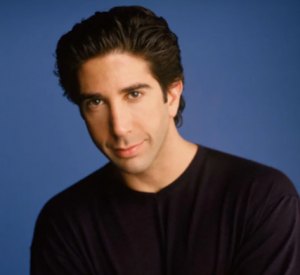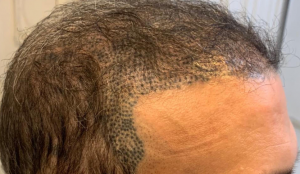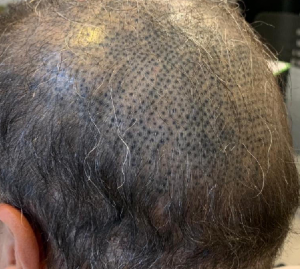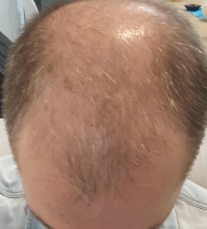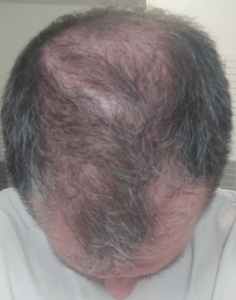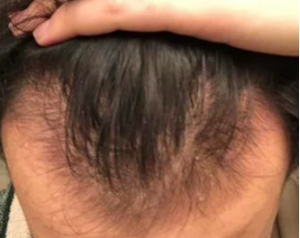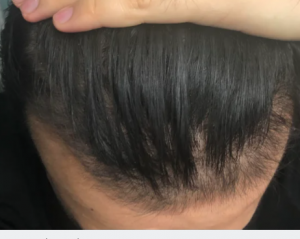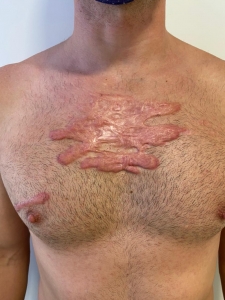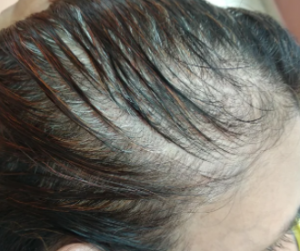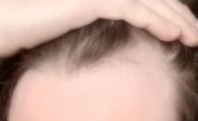Hello Doctor, may I ask if microneedling could induce hair regrowth in an area of the hairline that is completely bald?
I believe that it may be associated more with how long it has been bald there. If you are under 26 years of age, then the balding area might still have active stem cells but if you are 60, the stem cells might have died off by now.
Calling Men ‘Bald’ Counts as Sexual Harassment, UK Tribunal Rules – Bloomberg
Rassman Opinion: I believe that the context of the use ‘Bald” is the main issue. If it is used as part of other derogatory smears, then it may be clearly used as part of some ‘harassment’. Many men use the ‘balding’ term as part of their conversations with me and I likewise, will use it in a medical or social context as part of my work and would not consider it sexual harassment when I ask a man for his family balding history. Men use it as well, often in conversation without mal-intent.
As promised I am entering in the 7 months with complete photos took each month.
Routine:
finasteride 1mg every morning when i wake up
minoxidil twice a day
zinc + D vitamin 3 months cure After dinner
cafein + kératin 3 months cure After dinner for better absorption
microneedling once every 2 weeks at 0.5 to 0.75mm with 16 needle dermapen . If i go more than 0.75mm = bleeding which i do not want
15mn head massage twice a month
t gel shampoo once a week max.
essentiel oil shampoo that i have made (Cedar + ginger oil)
Amazing! This is strongly the work of microneedling plus help from everything else.
This man developed keloids or extreme hypertrophic raised scars possibly from some infection on his chest hairs or some injury like a burn. This is highly unusual in a Caucasian. Nevertheless, there are treatments for this which he will need to seek out.
Doctors who perform hair transplants must be aware of the keloid or hypertrophic tendencies of their patients as this would be a terrible complication on the scalp from a hair transplant impacting either the donor or recipient area. A small series of test grafts in an area where it can’t be seen, might give the patient and the surgeon comfort that a hair transplant will not produce such scars on a large scale if there is a history of such scarring.
If I was to get a hair transplant but my hairloss progressed to the point I had to shave my head how visible would the scarring be at the back? Would I have visible white dots on the back of my head or do they fade
Scarring from FUE is inevitable; however, the amount of scar may not be enough to see it or make the donor area see-through. The scarring that you can see or the see-through donor area is the result of too many FUE grafts being harvested. If you think about the average donor supply having 12,000 follicular units (grafts in a surgical sense), then if you remove only 3000 of them, you are only removing 25% of the total donor supply. In a medium weight hair, that can be tolerated provided that the punch size used is not too large. But if you extract 6,000 FUE with FUE, then the numbers reduce by 50% and problems may arise, especially if your hair is fine in character.
Is it possible to keep some of the growth you had if you stop minoxidil and/or finasteride? Or will it eventually fall back to where you started initially?
Any improvements depend upon continuation of these drugs. Stopping them, causes catch up hair loss
“Normally, between 40 and 100 hairs are shed daily on a non- shampoo day; twice as many are shed on days when the hair is shampooed.” Does that mean we shouldn’t shampoo?
Hair that is shed is not coming out because you shampoo your hair, it comes out because it is either going through its normal telogen cycle or you are losing it from miniaturization or genetic factors. Not shampooing your hair will make no difference in your overall hair volume or hair density across the scalp. Brushing it roughly will pull out miniaturized hairs so I generally tell men with hair loss to use a wide toothed comb
21M, been on finasteride for 3 months now, experienced huge shedding of around 150 hairs per day during the first month. It gradually stopped and now I shed less than 10 strands during a shower. Tried combing my hair onto a white cloth and found a lot of miniscule strands less than 1 cm long. I have pretty thick hair N1 but was receding a bit at the hairline.
Hair becomes miniaturized in the balding process and as it miniaturizes, its growth often slows down. Sooner or later the hair will fall out and the stem cells that were there, will die. We don’t know exactly when these stem cells die out so if the balding is recent, these stem cells can kick into action if they are stimulated properly with possibly microneedling or some new drugs that may yet come to market.
How many amounts of hair is considered a shed? I have been on finasteride for 2 years, I had some shed in the couple of first months but not ever since. I had 0 hairs, when I brushed my hands through my hair after shower. I noticed in the couple last weeks, that I am getting around 10-30 hairs when running my hands through my hair
Normal shedding is about 100 hairs per day. Multiply that out for 3 years and you will understand the turnover of the average persons hair as the typical anagen cycle would be 3 years. For shorter anagen cycles, the shed will be greater. Some younger women will have significantly less shed if their anagen cycle is longer like 4-5 years.
I am FtM transgender, and I have noticed a lot of transgender men in their mid-20s tend to get sudden and extreme hair loss due to hormone therapy (testosterone). Right now I’m not really experiencing much hair loss, possibly because I am on low-dose T, but I would like to prevent hair loss before it even starts.
Is there anything I can do to be proactive about hair loss? I currently only shampoo only 2-3 times a week, I condition daily, and I do 5-10 minute scalp massages daily. Are there any products I could incorporate into my hair routine?
Drugs like finasteride are critical but it most likely will not be enough to counter the impact of exogenous testosterone
Women are generally protected from generic hair loss by their production of estrogens. When they go through menopause, 50% of women get generalized thinning, rarely some patterned balding. They can also have other causes of hair thinning and its complicated. She should see her doctor for a workup. Have your mom read this: https://baldingblog.com/common-blood-tests-for-female-hair-loss/
Page 98 of 633

